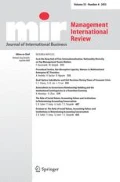Abstract and Key Results
-
This paper demonstrates the continued relevance of Penrose’s Theory of the Growth of the Firm (1959) (TGF) to explain MNE expansion patterns.
-
Explaining MNE growth requires explicit attention to three elements not addressed fully by Penrose: (1) technology-based firm-specific advantages, (2) dynamic capabilities and (3) melding location-bound and internationally transferable knowledge, especially through astute human resources management.
-
TGF includes foundational insights on the dynamic capabilities approach in strategy and contributes to assessing normative models in international strategy.
-
Penrose did not appreciate fully the unique knowledge recombination challenges prevailing in international business, especially in the context of the large MNE. This uniqueness of knowledge recombination is the raison d’être of international business as a separate field of inquiry.
Similar content being viewed by others
References
Augier, M./ Teece, D., Strategic Management, Entrepreneurship, and Design: The Evolving Influence of Edith Penrose and its Implications for Multinational Enterprise Strategy Analysis, Management International Review, 47,2, 2007 (this issue).
Buckley, P.J./ Casson, M., The Future of Multinational Enterprise, London: Macmillan 1976.
Buckley, P. J./ Casson, M., Edith Penrose’s Theory of the Growth of the Firm and the Strategic Management of Multinational Enterprises, Management International Review, 47,2, 2007 (this issue).
Dunning, J. H., American Investment in British Manufacturing Industry, London: Allen and Unwin 1958.
Dunning, J. H., Multinational Enterprises and the Global Economy, Wokingham: Addison-Wesley 1993.
Dunning, J. H., Location and the Multinational Enterprise: A Neglected Factor?, Journal of International Business Studies, 29,1, 1998, pp. 45–66.
Dunning, J. H., Towards a New Paradigm of Development; Implications for the Determinants of International Business Activity, Mimeo, Universities of Reading and Rutgers 2005.
Dunning, J. H./ Lundan, S. M., The MNE as a Creator, Fashioner and Respondent to Institutional Change, Mimeo, Universities of Reading, Rutgers and Maastricht 2006.
Ghemawat, P., Distance Still Matters: The Hard Reality of Global Expansion, Harvard Business Review, 79,8, 2001, pp. 137–147.
Goerzen, A./ Beamish P. W., The Penrose Effect: “Excess” Expatriates in Multinational Enterprises, Management International Review, 47,2, 2007 (this issue).
Hymer, S., The International Operations of National Firms: A Study of Foreign Direct Investment, Cambridge: MIT Press 1976.
Johnston, S./ Paladino, A., Knowledge Management and Involvement in Innovations in MNC Subsidiaries, Management International Review, 47,2, 2007 (this issue).
Penrose, E. T., Foreign Investment and the Growth of the Firm, Economic Journal, 66,202, 1956, pp. 220–235.
Penrose, E. T., The Theory of the Growth of the Firm, Oxford: Basil Blackwell 1959.
Penrose, E. T., The Growth of the Firm: A Case Study: The Hercules Powder Company, Business History Review, 34,1, 1960, pp. 1–23.
Penrose, E. T., Multinational Corporations, in Eatwell, J. (ed.), The New Palgrave: A Dictionary of Economics, London: Macmillan 1987, pp. 562–564.
Penrose, E. T., The Theory of the Growth of the Firm, 3rd edition, Oxford: Oxford University Press 1995.
Pitelis, C. N., The Growth of the Firm: The Legacy of Edith Penrose, Oxford: Oxford University Press 2002.
Pitelis, C. N., Edith Penrose and the Resource-based View of (International) Business Strategy, International Business Review, 13,4, 2004, pp. 523–532.
Pitelis, C. N., Edith Penrose and a Learning-Based Perspective on the MNE and OLI, Management International Review, 47,2, 2007 (this issue).
Rugman, A. M./ Verbeke, A., A Perspective on Regional and Global Strategies of Multinational Enterprises, Journal of International Business Studies, 35,1, 2004, pp. 3–18.
Steen, J. T./ Liesch, P. W., A Note on Penrosean Growth, Resource Bundles and the Uppsala Model of Internationalisation, Management International Review, 47,2, 2007 (this issue).
Tan, D./ Mahoney J.T., The Dynamics of Japanese Firm Growth in U.S. Industries: The Penrose Effect, Management International Review, 47,2, 2007 (this issue).
Verbeke, A./ Yuan W., Entrepreneurship in Multinational Enterprises: A Penrosean Perspective, Management International Review, 47,2, 2007 (this issue).
Author information
Authors and Affiliations
Rights and permissions
About this article
Cite this article
Pitelis, C., Verbeke, A. Edith Penrose and the future of the multinational enterprise: New research directions. MANAGE. INT. REV. 47, 139–149 (2007). https://doi.org/10.1007/s11575-007-0008-2
Issue Date:
DOI: https://doi.org/10.1007/s11575-007-0008-2




